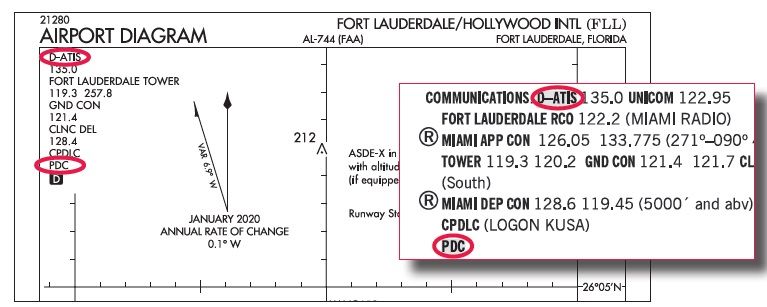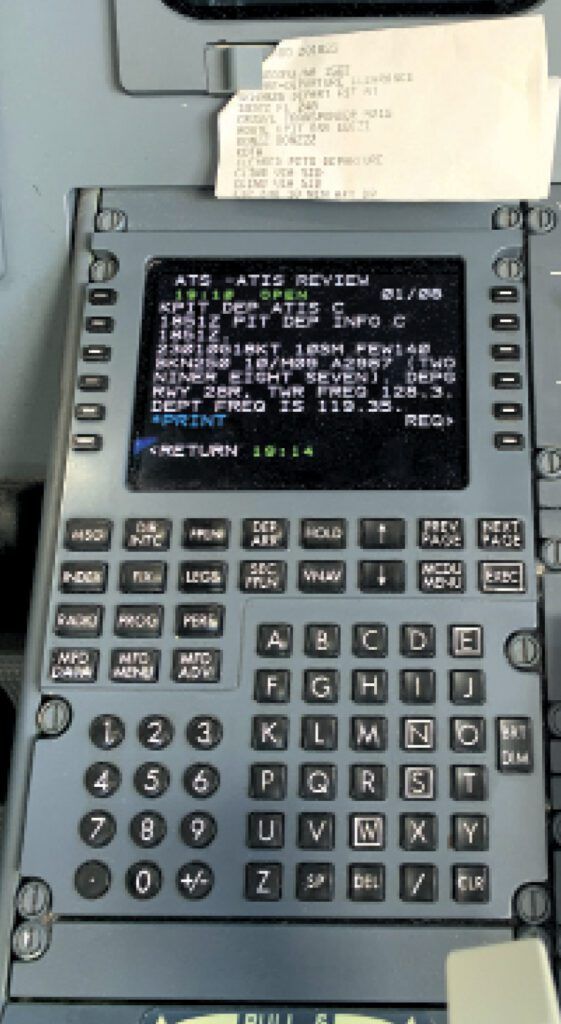Pre-Departure Clearance or PDC is an FAA computer service that provides clearance information in text form to your tablet in the cockpit via Boeing ForeFlight or Garmin FltPlan. No copying the ATIS or clearance calls are required. Great, eh?
Clearances issued via PDCs are official text clearances issued for U.S. IFR flight plans. A PDC is the same as a verbal clearance from Clearance Delivery and includes the filed route, the cleared altitude, transponder code, departure frequency, and any special instructions. In addition, your tablet will show digital ATIS—not just the latest METAR, but the actual ATIS—since the FAA packages PDC and D-ATIS as one service. (It’s common, but not universal, that both PDC and D-ATIS are available at the same airport.)
PDC Overview
About 75 large airports in the National Airspace System offer PDCs. Controllers generally like them because PDC reduces their workload. Unofficial lists of airports that support PDC appear on both vendors’ web pages, as noted below. Officially they’re listed in the Chart Supplement under Departure Procedure frequencies and on the airport diagram, as shown.
IFR clearances flow from an Air Route Traffic Control Center to a tower. A Clearance Delivery controller can append local departure information, say a DP and current ATIS information letter, and transmit the clearance via data link to a participating service provider’s computer. For instance, ForeFlight uses Honeywell as its provider.
The service provider delivers the aircraft’s clearance via a data link such as Aircraft Communications Addressing and Reporting (ACARS) for airlines, or cellular data service or Wi-Fi system using text, email, or both for the rest of us. PDC significantly reduces clearance frequency congestion, controller/pilot workload and minimizes delivery and readback errors.
Ideally, you never need to talk with Clearance Delivery. However, the FAA acknowledges that you, as PIC, should contact Clearance Delivery if a question or concern exists regarding an automated clearance. See AIM 5-2-2 for details.
PDC Limitations
Aircraft filing multiple flight plans are limited to one PDC clearance per departure airport within an 18-hour window. Additional clearances are delivered verbally. Since the subscription is by airplane, if two pilots go to the same airport in the same aircraft within 18 hours, the second pilot’s PDC won’t work.

Only IFR flight plans are supported. However, digital ATIS remains available even if the flight is VFR. Sometimes PDC will not deliver a Terminal Enroute Control Route.
Some PDC airports have specific rules concerning the aircraft types for which ATC will issue PDCs. Review the available departure procedures to ensure you receive your clearance correctly.
If the clearance is revised or significantly modified before delivery, PDC will reject it, and you’ll receive your clearance verbally. This safety measure ensures that you receive a valid clearance.
PDC does not need to know about your destination beyond what’s in your clearance. Ultimately, the Clearance Delivery controller decides whether to issue a clearance via PDC.
If successful, you need do nothing further. Your clearance appears in your EFB. Typically, no acknowledgment of receipt or readback is required for a PDC. You’ll then enter the clearance into your EFIS as usual.
Since PDC does not use the aircraft’s avionics, there are no additional expenses beyond paying for a subscription extension. The added cost might be worth it if you routinely depart IFR from PDC-capable airports.
Since the FAA owns PDC, the only differences will be in how ForeFlight and Garmin implement its functionality in their respective applications. Let’s take a quick look at their offerings.
ForeFlight’s PDC and D-ATIS
The link to Foreflight’s PDC page is foreflight.com/products/pdc.
A word of caution: The list of PDC airports is slightly different on both vendors’ sites, but all equipped airports offer the same PDC service. Hence, it’s unwise to purchase one or the other based on an unofficial list. Be sure your airport(s) of interest support PDC based on an official source before you buy.
You must purchase Foreflight’s Performance Plus or Business Performance subscription. Since the FAA packages PDC and digital ATIS into one service, users must purchase them that way.
Next, log into your ForeFlight account. Go to the Aircraft tab and click the Enable button under Clearance Delivery. This enables PDC for that aircraft, so ATC will assume you’re using it no matter who files the flight plan or flies the flight. Private ICAO addresses are also supported.
When you next file an IFR flight plan, a PDC badge will appear next to the departure airport and aircraft fields. If both show up, you’re all set. On one flight, a pilot accidentally filed a flight plan through a service other than ForeFlight and still got their PDC delivered to their cell phone.
Between 20-30 minutes before your filed departure time, you’ll receive email and text messages that include your complete, official clearance and the current ATIS. As usual, it’s valid for two hours after your ETD.
Your PDC will also be delivered to an email on file with the ForeFlight account if the flight plan email differs from the one on the account. Before engine start, enter your clearance into your EFIS and review D-ATIS in the app, text, or email.
FltPlan
PDC Premium Service is also sold by subscription and runs in the Garmin Pilot application. You must submit your IFR flight plan through Fltplan.com. Like ForeFlight, it eventually goes to ATC, which returns a PDC about 20-30 minutes before your filed departure time. Once received, it appears in the Active Flight Plan list. You can share it with the pilot, copilot, or another person in the account’s User/Pilot Info section. ForeFlight also supports this feature.
You can receive PDC notifications as email, text, or a pop-up that opens a window when the PDC message displays on an active flight plan list within 20-30 minutes.
PDC cannot operate until an aircraft tail number or call sign is registered with the FAA by FltPlan. See the online application link and an unofficial list of PDC-capable airports at fltplan.com/pdcinfo.htm.
FltPlan activation takes one or two business days. A call sign or flight number is satisfactory if it’s tied to the aircraft’s tail number. If you are in a flying club with one airplane and ten users, that’s fine. If you rent one plane and then another, that’s an issue for all airplanes except the one that’s registered.
Handling Delays
All the delay procedures are standard and should be familiar. If you must delay, call Clearance Delivery within 120 minutes, and they will extend or update your new departure time without the need to refile. After 120 minutes, the flight plan evaporates, after which you must refile and request your clearance by radio.
Some PDCs are challenging to interpret. Uniquely, FltPlan compiled eleven examples of troublesome PDCs. Regardless of which vendor you select, reviewing these can only help you. Of course, like any ATC communication, if you don’t understand, ask for clarification.

Expansion
The FAA announced D-ATIS in 1993 at 30 major airports. Today that number is 75. The number of PDC-enabled airports stands at 72, according to ForeFlight, and 78, according to FltPlan. It’s unlikely the FAA will expand it further.
Add It Up
PDC is a clever set of workarounds to avoid adding expensive avionics (e.g., a PDC receiver) by instead using a tablet and a existing standard data networks. Add D-ATIS for dessert, and it makes a great package where available.
Fred Simonds, CFII, approves of any technology that reduces workload and opportunity for error.






“The number of PDC-enabled airports stands at 72, according to ForeFlight, and 78, according to FltPlan. It’s unlikely the FAA will expand it further.”
Presumably, “likely” is intended here. Although, with FAA’s sub-glacial adaptation rate, it’s going to take approximately to the 22nd century to get all the airport comms digitized (1993 for D-ATIS??? 45 added in 30 years???).
Seriously, what could possibly be slowing the rate of such an obvious systemic improvement? We all carry computing and communicating devices with capabilities beyond the imagination of engineers and administrators of 1993. The last time I used an iPad on the highway, I clocked 120Mbps down, and 4Mbps up. And I did not have to dial in a frequency, listen to a Morse code (!) identifier, and confirm with a robo-voice to verify anything. The system routed my request to the best server, and delivered my requested report. It took a few seconds.
Similarly, voice cellular networks have been in place for 30 years, reliably switching connections on the fly, coordinating among 50,000 towers to get the best 4 or 5 at any moment. Without forcing the user to choose which tower and which frequency to tune into; without any fine-grained detailed charts that show “changeover points” along the route–just a bit of level sampling and stickiness in the automatic switchover decision logic.
It’s time for a generic “ATC-app” that accepts requests from pilots, and routes them to the appropriate ATC service provider. ATC, knowing the nature of the request (and the GPS location of the requester, and his airplane ID, and his name and address for that matter), responds with: clearance, runway/taxiway map, local weather, traffic info, NOTAM s, and, yes, digital ATIS…anything, really, to get the pilot on his way, and keep him safe en-route. All in milliseconds of elapsed time, all persisting on the pilot’s local video screen. There is nothing futuristic about such a scenario, absolutely zero technology risk. Time to stop talking, stop congratulating ourselves about how clever we are, and do something to improve overall system effectiveness.
> “It’s unlikely the FAA will expand it further.”
Why is it unlikely? The main infrastructure is already in place and it seems that it would only require a local controller to add color to the clearance if necessary. This seems like an easy win.